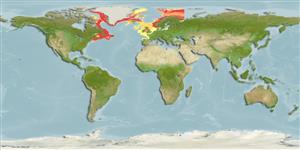Common names from other countries
>
Perciformes/Cottoidei (Sculpins) >
Cottidae (Sculpins)
Etymology: Artediellus: Petrus (Peter) Artedi, (10 Mar.) 1705-35 (28 Sep.), a son of a clergyman from Anundsjö named Olaus Arctaedius, in the northern part of Sweden.In 1729 he changed his name from Arctaedius to Arctædi, a name still later simplified to Artedi (Ref. 45335).
More on authors: Jordan & Evermann.
Environment: milieu / climate zone / depth range / distribution range
Ecología
marino demersal; rango de profundidad 35 - 900 m (Ref. 35388). Temperate; -2°C - 4°C (Ref. 35388); 80°N - 41°N, 71°W - 41°E
Northwest Atlantic: Greenland and Canada to Cape Cod in Massachusetts, USA. Northeast Atlantic: Greenland, Iceland, the Faroes, Novaya Zemlya (but not White Sea) in Russia, southern part of Barents Sea, Scandinavian coast to Skagerrak, the Orkneys in Scotland, and Ireland.
Tamaño / Peso / Age
Maturity: Lm ? range ? - ? cm
Max length : 15.0 cm SL macho / no sexado; (Ref. 35388); 10.6 cm SL (female); common length : 10.5 cm TL macho / no sexado; (Ref. 4698)
Gill membranes joined to each other under the throat, lateral line scales without bony knobs. Upper spine of the front gill cover curved upwards (Ref. 35388).
Occur on sandy or muddy bottoms (Ref. 4698). Benthic (Ref. 58426). Feed on polychaetes, small mollusks and very rarely small crustaceans (Ref. 4698). Lives at temperatures of -1.7-4°C. Females lay 50-350 eggs with a diameter of 4mm in late summer (Ref. 35388).
Fedorov, V.V., 1986. Cottidae. p. 1243-1260. In P.J.P. Whitehead, M.-L. Bauchot, J.-C. Hureau, J. Nielsen and E. Tortonese (eds.) Fishes of the North-eastern Atlantic and the Mediterranean. UNESCO, Paris. Vol. 3. (Ref. 4698)
IUCN Red List Status (Ref. 130435)
CITES (Ref. 128078)
Not Evaluated
Threat to humans
Harmless
Human uses
Herramientas
Special reports
Download XML
Fuentes de Internet
Estimates based on models
Preferred temperature (Ref.
115969): 0.4 - 7.4, mean 3 (based on 1117 cells).
Phylogenetic diversity index (Ref.
82804): PD
50 = 0.5000 [Uniqueness, from 0.5 = low to 2.0 = high].
Bayesian length-weight: a=0.00676 (0.00300 - 0.01523), b=3.17 (2.98 - 3.36), in cm Total Length, based on LWR estimates for this (Sub)family-body shape (Ref.
93245).
Nivel trófico (Ref.
69278): 3.6 ±0.38 se; based on food items.
Resiliencia (Ref.
120179): Bajo, población duplicada en un tiempo mínimo de 4.5-14 años (Fec=50).
Fishing Vulnerability (Ref.
59153): Low vulnerability (10 of 100).
